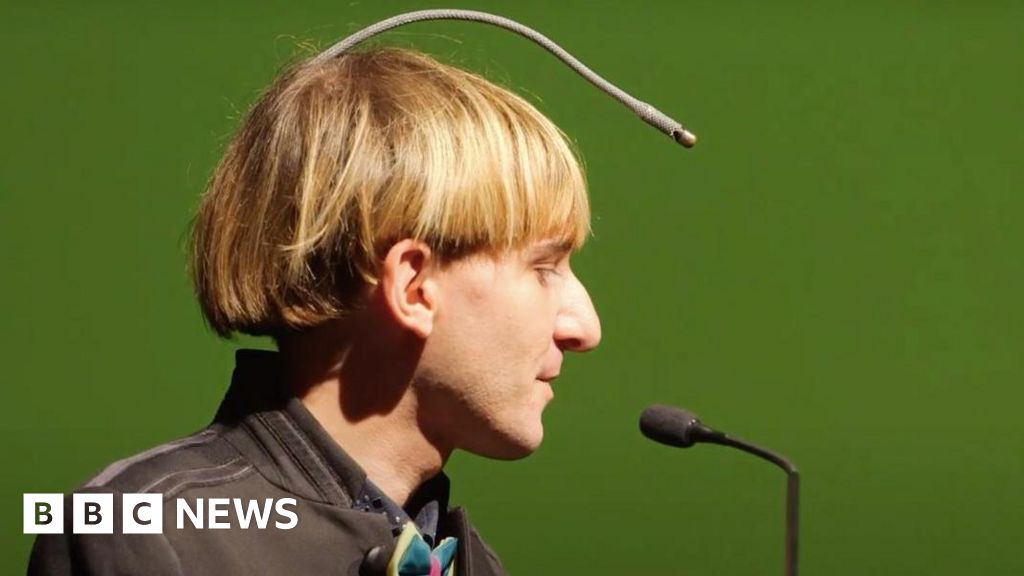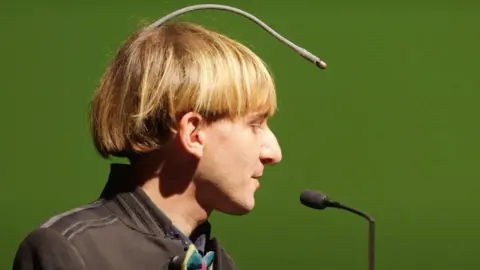 First born Movies
First born MoviesFor the past 20 years, the author “cyborg artist” Neil Harbisson has provoked debate with his “eyeborg” – a surgically attached antenna.
Harbisson, who grew up in Barcelona, is colorful, having been born with the rare condition achromatopsia, which affects one in 33,000 people.
This means that you see in what he calls “grayscale” – only black, white and shades of gray.
But he decided to have a surgery in 2004 that changed his life – and his senses – by attaching an antenna to the back of his head, which turns light waves into sound.
When the film director Carey Born met Harbisson, ranked by Guinness World Records as “the first officially recognized ‘cyborg’,” she was “stunned and amazed.”
His next step was to meet him, and then make a film about him – Cyborg: A Documentary.
Explore how he navigates his life, with the effects and implications of his unusual surgical procedure.
“The reason he did it was not to replace the feeling he was missing – it was to create an enhancement,” Born tells the BBC.
“So that was really the main hook that I found fascinating.”
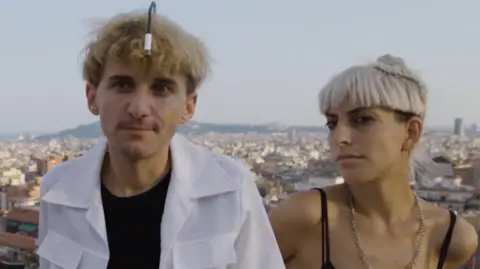 First born Movies
First born MoviesAs a student, Harbisson had met Plymouth University cybernetics expert Adam Montandon, who allowed him to “feel” color using headphones, a webcam and a laptop – turning light waves into sound
Harbisson took this experience, but he wanted more, fusing the technology with his own body – something that Spain’s bioethical committees have repeatedly rejected.
Eventually he convinced anonymous doctors to operate, removing part of the back of his skull so the antenna could be implanted and the bone could then grow over it.
Harbisson, who describes himself as a “cyborg artist,” said: “I don’t feel like I’m using technology, I feel like I’m technology.”
The term cyborg refers to a being with human and machine elements, giving it enhanced abilities.
Cyborgs are already a feature of popular culture and sci-fi, appearing in TV series such as Doctor Who, The Six Million Dollar Man and The Bionic Woman, and films including Terminator and Robocop.
 First born Movies
First born MoviesThe chip in the back of Harbisson’s head allows him to hear colors not through his ears, but through the bones of his skull. It also connects to nearby devices and even the internet.
His partner, Moon Ribas, says in the film: “He’s good, he likes to do things differently”, while he says that his antenna “allows me to broaden my perception of reality”.
Harbisson explains in the film that post-surgery, he had five weeks of headaches, and it took about five months to get used to the antenna.
Born says that after the procedure he had “depression, like when they did trepanning (a surgical intervention where a hole is drilled in the skull) in the 60s and 70s.
“People have had really big side effects — he’s had this, too.”
She admits she wasn’t sure what to expect when they first met, but found “Neil and Moon to be very personable … I think they make the subject matter accessible.”
The film shows how people respond to him, asking about his appearance, and we see him produce works of art based on his perception of color.
Allow Instagram content?
But life post-antenna has not been simple – the film also reveals that she received death threats, from people who objected to how she modified her body.
Harbisson touches on this in the film.
“For many years we’ve had various kinds of death threats, from people who really hate what we do, because they think it’s anti-natural or anti-God,” he says.
“So they think we should be stopped.”
The threats caused the couple to move their home to a new location, its precise location a carefully guarded detail.
Born says: “It’s a shame… they are very kind people.”
But he adds that his film injects possible notes of caution into the problem of body augmentation.
Harbisson’s credo, which includes his own business interests, is: “Design Yourself.”
But Born wants people to think about “security — and the potential for hacking in all these things that could result.”
“Is there a security issue as to who is doing it, what are the circumstances that are doing it, and what are the possible outcomes or consequences?” she adds.
A 2022 survey by the US think tank Pew Research Centerin AI and human enhancement, suggests that the American public may have some reservations.
Those surveyed were “generally more excited than worried about the idea of many potential changes to human capabilities.”
But many were “hesitant or undecided” about the merits of biomedical interventions to “change cognitive abilities or the course of human health.”
 Getty Images
Getty ImagesThe film also highlights that three years earlier, BBC News presenter Stephen Sackur highlighted possible ethical concerns about body augmentation.
He challenged Harbisson during an interview at the Swiss discussion conference, the St. Gallen Symposium.
“There are all kinds of ways in which this is troubling and alarming … not least because you call yourself transspecies, but you’re acquiring abilities that are beyond the ability of other human beings,” he said.
He also called for enhancements “only available to those who have the means to do this kind of thing, possibly creating a super-species.”
But Harbisson said his nonprofit Cyborg Foundation tries to make such increases “as available as possible.”
“It’s not expensive to create a new sense, but we give all these senses to machines,” he said, like cars or hand dryers.
“You can only add to your body – it’s just people who want to expand their perception.”
 Jenova Rain
Jenova RainBody modification artist Jenova Rain worked with Harbisson in 2018 during the Manchester Science Festival, and sees his work as “amazing and very important”.
“It’s pushing the limits of what we’re trying to achieve as a species,” he told the BBC.
“I think we need more people to be brave and bold like him.”
His work also includes the combination of technology and the human body – he implants microchips in the hands of people, making about 100 per year.
The microchip opens a door, for example, like an electronic key for a car.
“Primarily we were looking to make this accessible for people with disabilities, or mobility and dexterity issues, who struggle with keys specifically,” he told the BBC.
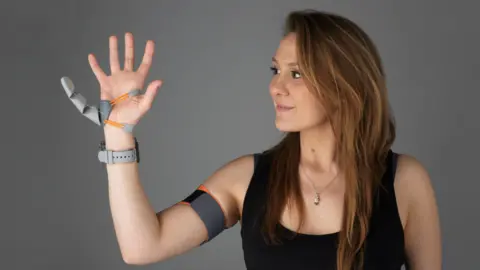 Dani Clode Design
Dani Clode DesignDani Clode, an augmentation designer for the University of Cambridge’s neuroscience plasticity lab, finds Harbisson “fascinating,” but says she and her colleagues are still working out whether augmentation is “a good thing, or is that a bad thing?”
“I’m choosing my words carefully here because it’s an exciting and interesting area. We just want to make sure it’s done safely,” he told the BBC.
His work includes the creation of a removable extra thumb and a tentacle arm.
Clode demonstrates the thumb, operated by a pressure pad under the wearer’s big toe.
“I make the devices, and the lab uses them to understand the future brain,” he explains, adding that they study the impact on the brain when the body is increased.
“After five days of training with this device (we learned) we can change the brain,” she says.
“We fundamentally changed how they used their hand for that week, which then showed up in their brain.”
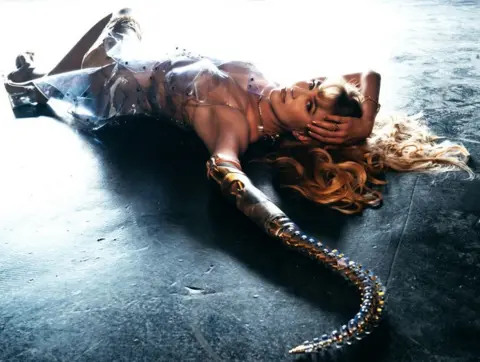 Dani Claude
Dani ClaudeBorn adds a final note of caution.
“Cybernetics is going to happen — it’s happening,” she says.
“I think that often politicians and regulatory bodies or those parts of the government are very slow, and that the technology does not allow.
“Technology is accelerating so fast, but we’re moving forward.”
She is concerned about who will end up holding the keys to cyber technology.
“If everything is in the hands of a few particular individuals, or a few influential organizations very elite, very rich, this is not a democratic process, and it will affect all of us.
“So I’m just warning people, in a nice and accessible way.”
Cyborg: The Documentary is in UK cinemas on September 20.
